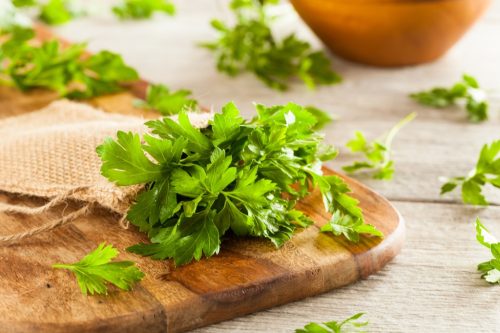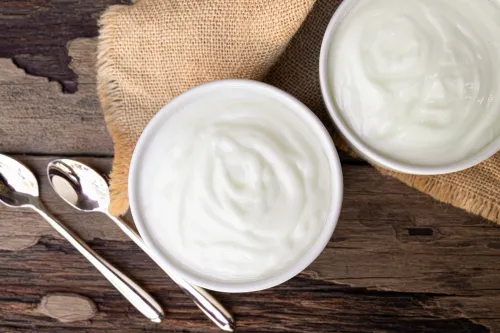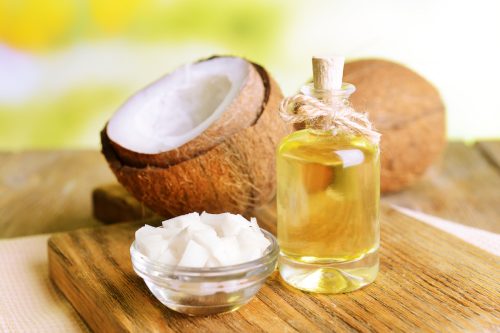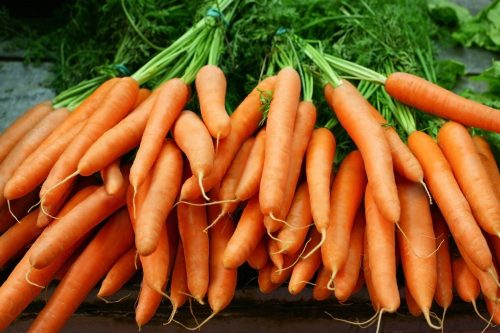5 Foods That Can Cure Your Dog’s Bad Breath

It’s almost a given that your dog will lick you when they’re excited or are feeling particularly affectionate. But if your pooch has a stinky mouth, those kisses can turn into an unwelcome gesture. More than that, if your dog has bad breath, it can signal larger oral hygiene problems such as periodontal disease or health issues including “heart, kidney, liver, and joint disease,” according to the American Kennel Club (AKC). If you’ve visited your veterinarian to rule out any of these conditions (and are keeping up on regular dental exams and teeth brushing), your next step may be to adjust your pet’s diet. According to vets, these common foods can help cure your dog’s bad breath.
RELATED: 11 Surprising Foods That Are Toxic to Dogs, According to Pet Experts.
1
Italian/flat or curly parsley

Parsley is more than just a garnish for your favorite recipe. According to Sabrina Kong, DVM, staff veterinarian writer at WeLoveDoodles, Italian/flat and curly parsley contain chlorophyll, which helps minimize the odor in your dog’s mouth. (Steer clear of spring parsley, though, as it is toxic to dogs!)
“Adding fresh parsley to your dog’s diet can help freshen their breath from the inside out,” says Kong. “Chlorophyll doesn’t just mask the odor; it also helps to neutralize internal body odors and aids in digestion, which is often a source of bad breath.”
Adam Guest, co-founder of homemade pet food company Raw & Fresh, agrees that these two types of parsley can mitigate bad breath. However, he cautions against feeding your dog too much. “Ensure it’s used in moderation, as large amounts can be harmful,” he says. Ask your vet about how much parsley is safe for your particular dog breed to consume.
RELATED: I’m a Veterinarian and These Are the 10 Things You’re Doing That Your Dog Hates.
2
Cilantro

Speaking of herbs, cilantro can also help improve a dog’s breath. However, it might not be their favorite thing to eat.
“Though cilantro is not toxic to dogs, most dogs do not like the taste of cilantro,” explained Jerry Klein, DVM, chief veterinary officer for the AKC, in an article on the organization’s website. Try feeding it to them in small quantities to gauge their reaction.
Additionally, dogs should only eat cilantro leaves. “The stems are difficult to digest and may lead to gastrointestinal issues in some dogs when eaten,” Klein cautioned.
3
Unsweetened probiotic yogurt

Unsweetened probiotic yogurt can be an easy fix for bad breath, but it’s important to only feed it to your dog in moderation, as it contains lactose, which “many canines might have trouble digesting,” notes the AKC.
Guest points out that bad breath sometimes occurs because of digestive issues, and the probiotics in yogurt can help mitigate this.
“The live cultures in probiotic yogurt help in combating bad bacteria in the mouth and the gut, leading to fresher breath,” explains Nick Horniman, MRCVS, veterinary surgeon and founder of online pet pharmacy MyPetsVet.
However, Horniman cautions that you’ll need to “choose a product that is free from xylitol and artificial sweeteners, as these can be harmful to dogs.”
RELATED: I’m a Dog Trainer and I’d Never Own These 5 Breeds “Unless My Life Depended on It.”
4
Coconut oil

It’s easy to introduce coconut oil into your dog’s diet since all it takes is adding a small amount to their food. Not only does it cure bad breath, but it’s also great for oral hygiene.
“Its antimicrobial properties can help reduce harmful bacteria in the mouth, a common cause of bad breath,” explains Kong. “Additionally, coconut oil can help improve the condition of your dog’s gums and teeth.”
Kong notes that you should only feed your dog virgin, unrefined coconut oil and that you should introduce it gradually into their diet to avoid any digestive issues.
5
Carrots or apples

Carrots and apples are safe for dogs to eat and they’re great for their oral health.
“These can help clean your dog’s teeth, acting like natural toothbrushes to remove plaque, which can help improve breath,” says Guest.
If your dog isn’t keen on eating these foods at first, Guest says to “cut them into appropriate sizes” and/or add them into their regular dog food.
Of course, when making any major dietary changes to your dog’s diet, it’s always advisable to consult your veterinarian first.